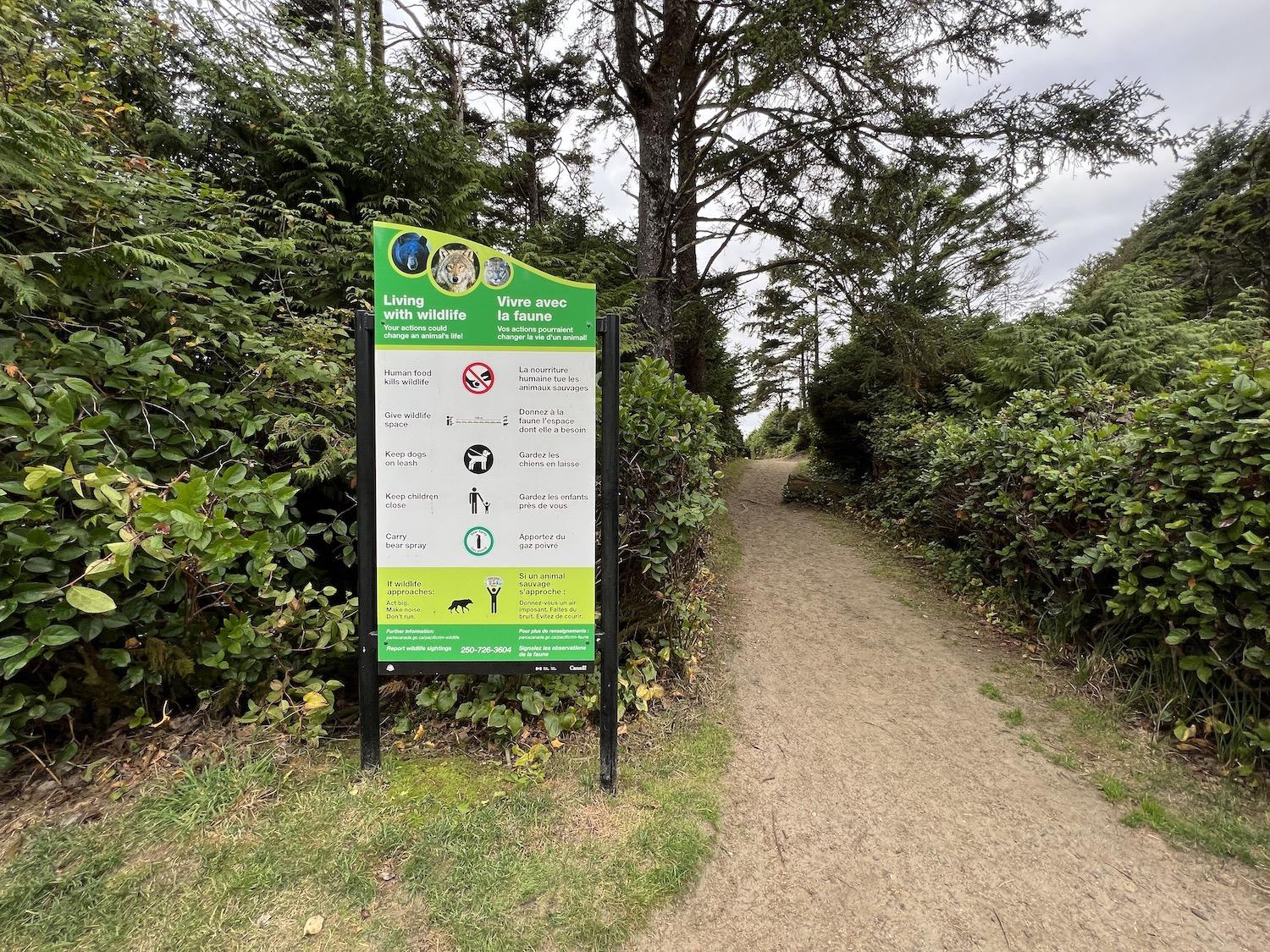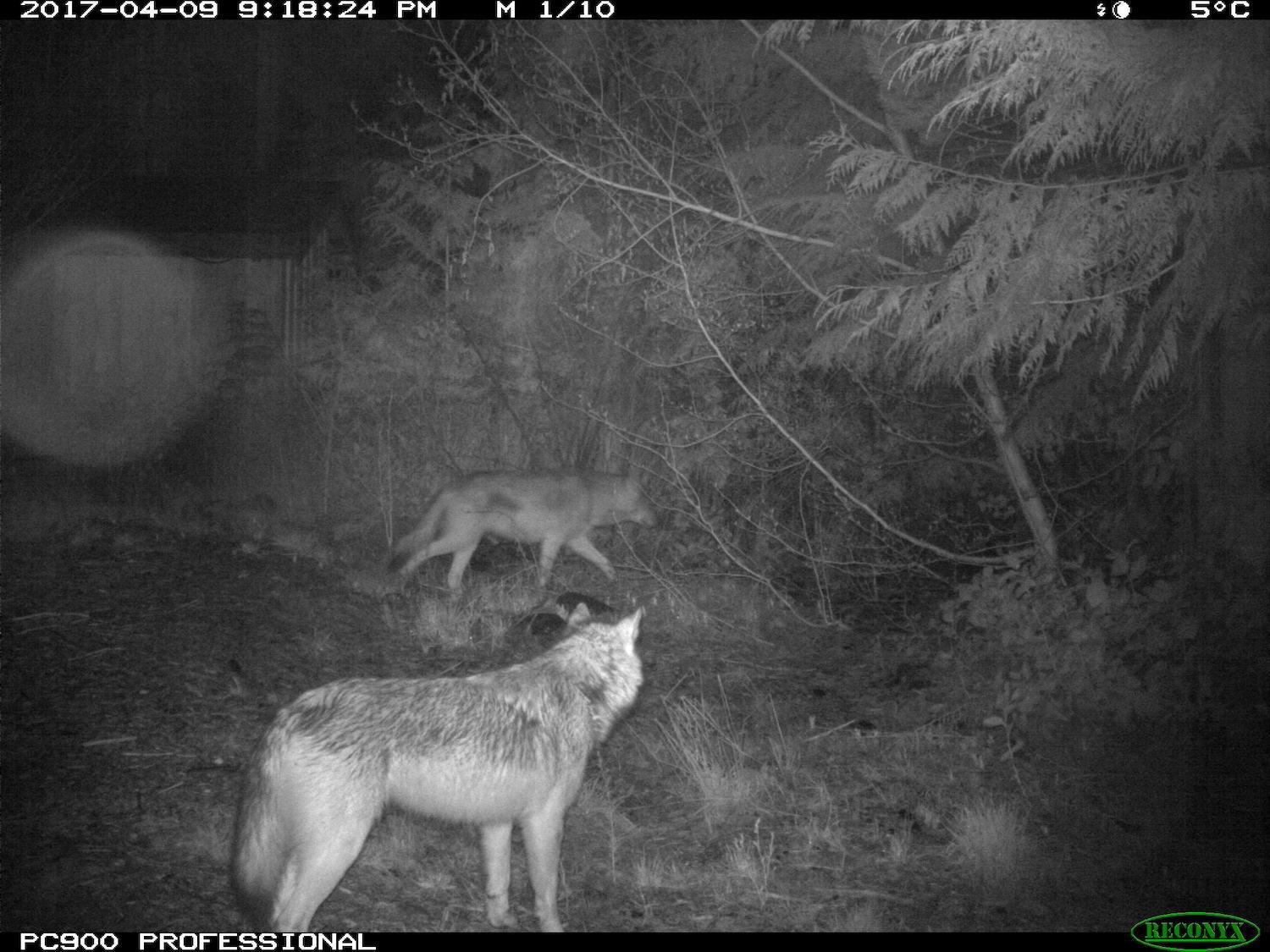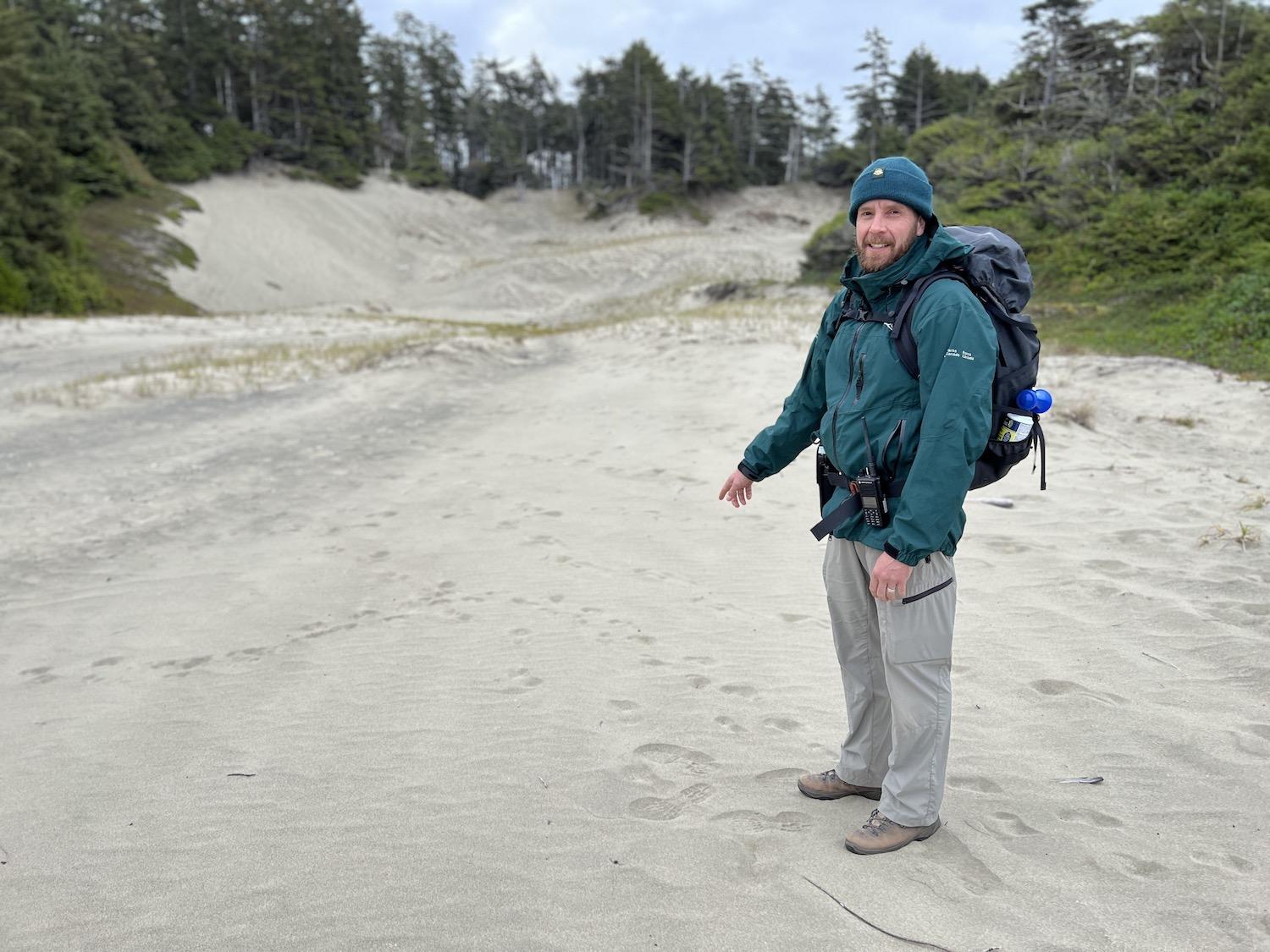
This billboard along the highway to Tofino in Pacific Rim National Park Reserve is part of the Wild About Wolves research project/Jennifer Bain
Driving down the Pacific Rim Highway on route to the wildly popular town of Tofino, a roadside billboard that wasn’t trying to tell me where to sleep, eat or shop jumped out with its striking photo and stark message.
The photo didn’t show blissful visitors surfing, storm watching, hiking in the rainforest or admiring whales, but rather a lone wolf gripping a plastic water bottle in its teeth.
The message was conveyed with just four words — one of them in bold: “Human food kills wildlife.”
The billboard, erected in Pacific Rim National Park Reserve in British Columbia, was the work of Parks Canada. It’s part of a research project called Wild About Wolves that hopes to improve co-existence between people and wolves by raising awareness of the species and conveying the importance of sharing space.

National park visitors should always make time to read signs, like this one that warns people about how their actions can impact an animal's life/Jennifer Bain
For the next few days on Vancouver Island, I ruminated about wolves every time I drove by that billboard or walked by smaller signs at beaches and trailheads that showed photos of a wolf, black bear and cougar and warned “your actions could change an animal’s life.”
Give wildlife space. Keep dogs on a leash and children close. Report wildlife sightings. Read signs posted in parking lots and at trailheads. Prevent wildlife from getting into your food or garbage. Carry bear spray.
Check. Check. Check. More or less.
I scowled righteously at dog owners wilfully disobeying the rules on the beach because they felt their pets’ freedom trumped the fact that wildlife can lose their natural wariness of humans and become a public safety risk after repeat encounters with off-leash dogs.

National park beaches, even when they're empty, are home to wildlife and no place for off-leash dogs/Jennifer Bain
But I didn’t do everything right either.
Being from the city, I don’t own (or travel with) expensive bear spray, so I dropped a couple of bucks on a neon orange Parks Canada whistle and attached it to my jacket zipper. I hiked alone on a few short trails — never a good idea in areas with major predators — before deciding it wasn’t worth the stress. And while I didn’t see wolves or anything bigger than a squirrel, I finally realized how wrong I was to have prolonged and photographed wildlife encounters in the past.
“Scare, do not stare,” is Parks Canada’s mantra.
“Instead of stopping to take a picture, help reinforce natural, healthy wariness of humans — make noise, act big, and do not run.”
Pacific Rim doesn’t “actively encourage people to seek out wildlife for photography,” and advises those lucky enough to observe wildlife from a safe distance of greater than 100 metres (330 feet or 10 bus lengths) to use a telephoto lens.

Parks Canada's Todd WIndle shows a wildlife camera that's being used to study wolves in Pacific Rim National Park Reserve/Jennifer Bain
I wondered if my instinct to document everything with words and photos would be tested when I went for a walk with Todd Windle, the Wild About Wolves project manager. The five-year project grant that started in the summer of 2018 was extended because of the pandemic until March 31, 2024.
Windle told me how human-wolf interactions have been rising in this park reserve. Litter, off-leash dogs and people getting too close have made wolves less wary and caused them to associate humans with food.
Between the 1960s and 1990s, grey wolves were considered extirprated from Vancouver Island largely due to government-sponsored culls. Then they started swimming over from other islands, possibly attracted by a flourishing deer population.
“This was natural — it wasn’t a reintroduction program,” said Windle. “They moved island to island and worked their way down, from north to south, and from east to west.”

Wolves captured by wildlife cameras in Pacific Rim National Park Reserve/Parks Canada
Accurate statistics are pending but he estimates there are several hundred wolves on the island now and says these coastal wolves are likely genetically different from the original sub-species.
Parks Canada has welcomed the wolf's return. So have the Nuu-chah-nulth peoples who have co-existed with wolves here in their traditional territories for thousands of years and who consider the animal sacred to their livelihood, culture and spirituality. But at the same time, the average citizen (and visitor) has forgotten how to live with wolves or doesn't know how to.
Conflicts began escalating around 2017, when Parks Canada had to put down one wolf and the province destroyed another. Parks Canada started researching wolves in the park reserve’s Long Beach, West Coast Trail and Broken Group Islands units, bringing together First Nations, government agencies, academics and residents.
“We’re combining science and traditional knowledge in an approach that is sometimes called two-eyed seeing,” Windle explained. “It’s a term coined by MI’kmaw Elder Albert Marshall. It’s about learning to see from one eye with the strengths of Indigenous knowledge and ways of knowing, and from the other eye with the strengths of Western knowledge and ways of knowing. And then learning to use both of these together for the benefit of all.”

Todd Windle explores the sand dunes of Wickaninnish Beach looking for wolf tracks and scat/Jennifer Bain
Windle, who has long specialized it human-wildlife interactions involving terrestrial carnivores, is trying to switch from saying wolf "packs" to saying wolf “families” — a more respectful and responsible term.
He's also trying to better understand wolf movements and behavior, as well as relationships between individual wolves and families, population density and diet composition. Wildlife cameras at about 100 sites are picking up wolves plus their competition and prey species. More than 175 samples of scat have been collected and will be tested to understand wolf diet, ancestry and kinship.
Also being studied are the human dimensions of wildlife — the attitudes, values and beliefs that affect the decision-making process of visitors and locals. A PhD candidate did lengthy interviews with people with an interest in wolves last year, and there have been facilitated workshops. Information cards for the online “People, Parks, and Wolves Survey” are being handed out to visitors.
“The highway sign was actually one of the first things we were able to do," said Windle, explaining that it was adapated from messaging in Banff National Park to do with food-conditioned wolves. “Our Elders’ Working Group approved that and were quite supportive of that sign, which was done intentionally to make you think and draw your attention to it and ask questions.”

Wolf scat found along a trail in Pacific Rim National Park Reserve has a distinctive look to it/Todd Windle, Parks Canada
With the results from all these efforts, Parks Canada hopes to know how to better direct the types of education and mitigation that are needed.
One thing that Windle really wants people to understand is how habituation and food conditioning change the behavior of wolves and other species.
Habituation happens when an animal, over repeated interactions with people that don’t have any negative consequences, loses or reduces its natural wariness. It might start traveling beaches by day instead of night, or wandering closer to campsites. Food conditioning means linking humans and food after being directly fed or having access to garbage, human food, pet food and pets.
Once animals start seeking food in parking lots and campgrounds and beside roads, they’re more likely to be hit by cars, shot by hunters or killed by various authorities.
“It’s a shared responsibility,” stressed Windle. “People come here to co-exist, so keep attractants away, don't get close for those photographs and don't send pets out off leash.”

Wolf tracks in the sand on a Pacific Rim National Park Reserve beach/Todd Windle, Parks Canada
It was a longshot, but after chatting indoors over coffee, we drove to Wickaninnish Beach on the off chance we’d see a wolf, or at least fresh scat or tracks in the sand. Wolves travel and hunt along the shore, but this particular beach also has dunes that are somewhat protected from the wind and are set far enough back from the ocean that the tide won’t wash away animal tracks.
Windle led me to one very old wolf scat, which is about the same size and shape as dog poop, but is long and twisted like rope with twisted ends and often contains bones and hair.
Talk turned once again to people prolonging wildlife interactions for photographs.
“For almost everybody that’s going to be a once-in-a-lifetime experience and it's natural to think `wow’s that’s incredible' in the moment, and to do whatever you might hope to do to make it last longer,” said Windle. “But with 1.2-million people coming here every year, that’s the potential for a lot of once-in-a-lifetime experiences that could really add up to a habituated wolf and can lead to food conditioning down the road.”

We didn't see any fresh evidence of wolves on Wickaninnish Beach, only these endangered Pink Sand-verbena/Jennifer Bain
Most people aren't going to try and feed a wolf or deliberately leave food waste behind, he conceded. But both those things can and do happen and "the prevention side is really so much easier than trying to correct things after the fact.”
A lot happened on our short beach walk on the Wickaninnish dunes.
I saw endangered Pink Sand-verbena and learned how the sensitive area provides critical habitat for Yellow Sand-verbena. I hung back when Windle had to have a quiet word with off-leash dog owners who looked guilty the moment he started walking towards them. We had an unusual close encounter with a raven — and yes, I instinctively photographed it.
The only wolf we saw, though, was the weathered wooden one depicted in a house post carved by Clifford George of the Yuułuʔiłʔatḥ First Nation and placed near the Kwisitis Visitor Centre.

A First Nations house post carved by Clifford George and depicting a wolf can be found near Wickaninnish Beach/Jennifer Bain
We moved on to a more remote spot that I promised not to identify to see a wildlife camera set up at wolf level. Windle demonstrated how the motion-triggered cameras work, and detailed how they are kept in metal cases because of curious bears and locked to trees because of humans who unfortunately sometimes try to steal them.
A few weeks later, back in my home in Canada's largest city, I finally made time to fill out the online "People, Parks, and Wolves Survey" — which is being handled by the University of Saskatchewan School of Environment and Sustainability. I don't live among wolves, so had to select "not applicable" for some answers. But I do travel to wolf territory on occasion and so most of the questions were what should be considered no-brainers.
"I believe that feeding wolves results in dead wolves." Strongly agree.
"Problems arising from wolves in the park are everyone's responsibility." Strongly agree.

 Support Essential Coverage of Essential Places
Support Essential Coverage of Essential Places




Comments
Very good article.